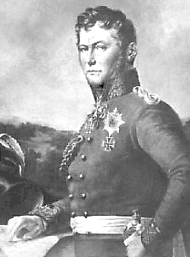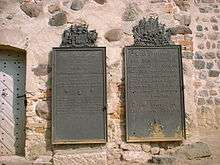Karl Friedrich von dem Knesebeck
| Karl Friedrich von dem Knesebeck | |
|---|---|
 Field Marshal von dem Knesebeck | |
| Born |
5 May 1768 Karwe (Carwe) near Neuruppin, Prussia |
| Died |
12 January 1848 (aged 79) Berlin, Prussia |
| Allegiance |
|
| Service/branch | Army |
| Years of service | 1782–1848 |
| Rank | Field Marshal |
| Unit |
Regiment von Kalkstein Regiment Duke of Brunswick Prussian General Staff Feldjäger-Korps |
| Commands held |
Mounted Feldjäger Corps Army of Occupation, Posen |
| Battles/wars | |
| Awards |
Pour le Mérite with Oak Leaves Order of the Black Eagle Iron Cross Order of St. Andrew[1] For others see Section below. |
Karl Friedrich von dem Knesebeck (5 May 1768– 12 January 1848) was a Prussian field marshal and military adviser in the Napoleonic Wars.
Early life
Knesebeck was born on the family estate Karwe, close to Neuruppin in the Margraviate of Brandenburg, as the son of an officer who had served under King Frederick the Great in the Seven Years' War. Knesebeck entered military service in 1783, when he was commissioned into the Regiment of General von Kalckstein in Magdeburg. As he showed a keen interest in poetry, he soon made friends with the later famous authors and poets Friedrich de la Motte Fouqué and Heinrich von Kleist, who served with him during his early career. In 1787 he was posted to the Regiment of the Duke of Brunswick.
With this regiment Knesebeck came to Silesia in 1790. As a young lieutenant and writer, he became friends with Johann Wolfgang von Goethe. During this time he was mentored by Johann Wilhelm Ludwig Gleim, with whom he maintained a lengthy correspondence.
Wars against France
In the campaign of 1792-94, Knesebeck was noticed by the Duke of Brunswick for his ability and diligence; The duke ordered him to his staff in 1794, where he was promoted several times (1797 Premierlieutenant, 1799 Captain, 1802 Major).
In 1803, as adjutant to General von Rüchel and motivated by him, Knesebeck wrote a memorandum to the Duke of Brunswick as to the effect of the need of a Landwehr (militia), which he called "the Legion of Honour" of the Prussian state. This idea formed part of the later reorganisation of the Prussian Army by Gerhard von Scharnhorst.
In December 1803, Knesebeck was promoted to Quartermaster in the General Staff. With a mission for William I, Elector of Hesse, he began a series of diplomatic services for Prussia.
For most of the War of the Fourth Coalition in 1806, Knesebeck served with General Rüchel’s staff. In the Battle of Auerstedt, it was reportedly due to Knesebeck’s decisive cavalry action that King Frederick William III of Prussia evaded capture.
Knesebeck showed strategic abilities with the planning of the victorious Battle of Pułtusk on 26 December 1806. The King awarded him the Pour le Mérite [2] and promoted him to Lieutenant-Colonel on 16 May 1807.
Following the Treaties of Tilsit, Knesebeck was discharged from military service upon his own wish on 21 September 1807 and returned to his estates in Neuruppin and Tylsen. However, he was called back into service and received a secret order to observe enemy action in Austria and to report any opportunity for military action.
In 1812 Knesebeck received a new diplomatic task, the success of which later created the basis of the allies’ later victories against Napoleon in 1813. He received the official mission from the Prime Minister of Prussia, Hardenberg, to inform Tsar Alexander I of Russia that Napoleon would deem it necessary to invade Russia, should the tsar not lay down his arms. Simultaneously, he was secretly ordered by the King of Prussia to persuade the Russian Emperor into luring Napoleon into the wide extremities of his country and not to make peace until Napoleon’s Grande Armée had worn itself down. According to Knesebeck’s own writings, the tsar answered that he would not "make peace, even if I would have to retreat to Kazan".
On 6 March 1813 Knesebeck was promoted to Colonel and Adjutant-General to the king; in the same year he was promoted to Lieutenant-General. The war of the years 1813-1815 he largely experienced in the king’s headquarters, where he designed the campaign plan of the Battle of Leipzig and the subsequent invasion of France, for which he was awarded the Oak Leaves to his Pour le Mérite, as well as the Russian Order of Saint Vladimir.
In 1815 Knesebeck married Adolphine Susanne Luise Karoline Johanna von Klitzing.
Knesebeck was again called to diplomatic services in 1815 to negotiate with Vienna to the effect of an Austrian participation in the Seventh Coalition. Later he accompanied the king to London and took part in the Congress of Vienna.
Post-War

In 1822 Knesebeck became commander of the mounted Feldjäger Corps, while remaining Adjutant-General to the king. In 1823 King Frederick William III gave him the estate Huysburg,[3] in recognition of his services. Knesebeck was promoted to full General in 1825 and was appointed commander-in-chief of the army in the Grand Duchy of Posen. He received the Order of the Black Eagle in 1832 and the Order of St. Andrew in 1834, the highest awards of Prussia and Russia respectively.
On 7 October 1847 Knesebeck was offered a promotion to active field marshal by King Frederick William IV of Prussia, which he declined due to his advanced age. He requested his discharge from the army, which was granted him with a simultaneous promotion to field marshal. He died on 12 January 1848 in Berlin.
On the church in Neuruppin-Karwe hangs a memorial to Knesebeck, with the inscription:
"Carl Friedrich von dem Knesebeck, born in Carwe 1768, died in Berlin 1848. A Prussian field marshal, he fought for the honour of his King and Country in 17 battles and served to the glory of his fatherland from his 13th year until his death. Peace to his remains, honour to his memory."
Works
- “Lob des Krieges” (“Praise of war,” 1805), a poem which enjoyed great popularity[4]
Honours
.svg.png) Prussia: Pour le Mérite with Oak Leaves
Prussia: Pour le Mérite with Oak Leaves.svg.png) Prussia: Order of the Black Eagle; collar ("chain") of the order in 1847
Prussia: Order of the Black Eagle; collar ("chain") of the order in 1847.svg.png) Prussia: Order of the Red Eagle
Prussia: Order of the Red Eagle.svg.png) Prussia: Order of Hohenzollern
Prussia: Order of Hohenzollern.svg.png) Prussia: Iron Cross, 1st Class. One of the first awarded.
Prussia: Iron Cross, 1st Class. One of the first awarded..svg.png) Prussia: Service Award Cross
Prussia: Service Award Cross Austrian Empire: Order of Leopold
Austrian Empire: Order of Leopold.svg.png) Bavaria: Military Order of Max Joseph
Bavaria: Military Order of Max Joseph.svg.png) Russian Empire: Order of St. Andrew
Russian Empire: Order of St. Andrew.svg.png) Russian Empire: Order of St. Alexander Nevsky
Russian Empire: Order of St. Alexander Nevsky.svg.png) Russian Empire: Order of the White Eagle
Russian Empire: Order of the White Eagle.svg.png) Russian Empire: Order of St. Vladimir
Russian Empire: Order of St. Vladimir.svg.png) Russian Empire: Order of St. Anna
Russian Empire: Order of St. Anna.svg.png) Russian Empire: Order of Saint Stanislaus
Russian Empire: Order of Saint Stanislaus Sweden: Order of the Sword
Sweden: Order of the Sword Kingdom of France: French Order of Military Merit
Kingdom of France: French Order of Military Merit
Literature
- Jürgen Hahn-Butry (Hrsg.): Preußisch-deutsche Gemeralfeldmarschälle und Großadmirale. Safari, Berlin 1937.
- Olaf Jessen: Preußens Napoleon? Ernst von Rüchel. 1754-1823. Krieg im Zeitalter der Vernunft, Paderborn u. a. 2006.
- A. von dem Knesebeck: Haus und Dorf Carwe in der Grafschaft Ruppin. Berlin 1865.
- Dr. Karl Griemank (Hrsg.): Gneisenau. Ein Leben in Briefen. Koehler & Umelang, Leipzig 1939.
References
- ↑ A. von dem Knesebeck: Haus und Dorf Carwe in der Grafschaft Ruppin. Berlin 1865
- ↑ Persons awarded the Pour le Mérite
- ↑ German Huysburg Website
- ↑
 Rines, George Edwin, ed. (1920). "Knesebeck, Karl Friedrich von dem". Encyclopedia Americana.
Rines, George Edwin, ed. (1920). "Knesebeck, Karl Friedrich von dem". Encyclopedia Americana.
External links
| Titles of nobility | ||
|---|---|---|
| Preceded by Friedrich Wilhelm Leopold |
Baron von dem Knesebeck (in Prussia) – |
Succeeded by Alfred Cuno Paridam |